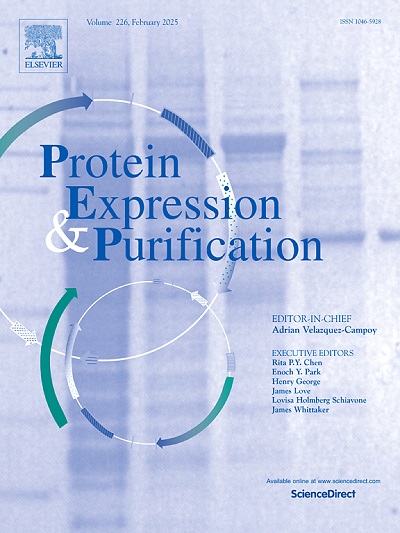Optimization of CYP27A1 recombinant protein expression
IF 1.2
4区 生物学
Q4 BIOCHEMICAL RESEARCH METHODS
引用次数: 0
Abstract
Human mitochondrial cytochrome P450 27A1 is a monooxygenase enzyme that oxidizes bile acids and other sterol derivatives. The enzyme plays an important role in sterol metabolism and is a potential target for clinical therapies related to metabolic conditions and certain cancers. To support the development of such therapies, detailed structural and functional studies of the enzyme should be pursued. Producing large quantities of purified, recombinant enzyme would enable these studies. Recombinant production of human cytochrome P450 27A1 in E. coli is challenging due to the enzyme being membrane associated. This work explores the optimization of human cytochrome P450 27A1 expression in E. coli by systematically testing the effects of cell strain, expression temperature, concentrations of induction reagents, and expression times. Western blot analysis is used to investigate the effects of variable changes prior to purification. E. coli cell strain (switching to C41(DE3)) appears to have the largest positive effect on overall yield. Increasing δ-aminolevulinic acid concentration (induces heme synthesis) also leads to significantly increased yields. Decreasing expression time decreases the amount of higher order cytochrome P450 aggregates that are formed. The combination of these changes is a more robust expression protocol with three major advantages: decreased expression time, lower aggregate to monomer ratios, and increased overall yield.
CYP27A1重组蛋白表达的优化。
人类线粒体细胞色素P450 27A1是一种单氧酶,可氧化胆汁酸和其他甾醇衍生物。该酶在固醇代谢中起着重要作用,是与代谢疾病和某些癌症相关的临床治疗的潜在靶点。为了支持这种疗法的发展,应该对这种酶进行详细的结构和功能研究。生产大量纯化的重组酶将使这些研究成为可能。在大肠杆菌中重组生产人类细胞色素P450 27A1是具有挑战性的,因为酶是膜相关的。本工作通过系统地测试细胞株、表达温度、诱导试剂浓度和表达时间对人细胞色素P450 27A1在大肠杆菌中的表达的影响,探讨了人细胞色素P450 27A1在大肠杆菌中的表达优化。Western blot分析用于研究纯化前变量变化的影响。大肠杆菌细胞株(切换到C41(DE3))似乎对总产量有最大的积极影响。增加δ-氨基乙酰丙酸浓度(诱导血红素合成)也能显著提高产量。减少表达时间减少了形成的高阶细胞色素P450聚集体的数量。这些变化的结合是一个更健壮的表达方案,具有三个主要优点:缩短表达时间,降低聚合与单体的比例,提高总体产量。
本文章由计算机程序翻译,如有差异,请以英文原文为准。
求助全文
约1分钟内获得全文
求助全文
来源期刊

Protein expression and purification
生物-生化研究方法
CiteScore
3.70
自引率
6.20%
发文量
120
审稿时长
32 days
期刊介绍:
Protein Expression and Purification is an international journal providing a forum for the dissemination of new information on protein expression, extraction, purification, characterization, and/or applications using conventional biochemical and/or modern molecular biological approaches and methods, which are of broad interest to the field. The journal does not typically publish repetitive examples of protein expression and purification involving standard, well-established, methods. However, exceptions might include studies on important and/or difficult to express and/or purify proteins and/or studies that include extensive protein characterization, which provide new, previously unpublished information.
 求助内容:
求助内容: 应助结果提醒方式:
应助结果提醒方式:


